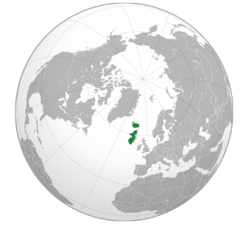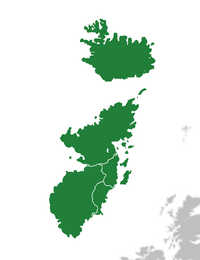Nelborne: Difference between revisions
mNo edit summary |
No edit summary |
||
| Line 1: | Line 1: | ||
{{WIP}} | {{WIP}} | ||
{{About|the archipelago|the political and economic union|Nelborne Union|the island|Nelbecia}} | {{About|the archipelago|the political and economic union|Nelborne Union|the island|Nelbecia}} | ||
Nelban | |||
{{Infobox continent | {{Infobox continent | ||
|title = Nelborne | |title = Nelborne | ||
{{unbulleted list|item_style=font-size:88% | |||
| Nelban {{resize|80%|{{nobold|([[Alquiyan language|Alquiyan]], [[Lormotian language|Lormot]])}}}} | |||
| Neban {{resize|80%|{{nobold|([[Fjeskan language|Fjeskan]])}}}} | |||
| Nelbóvíu {{resize|80%|{{nobold|({{wp|Icelandic language|Icelandic}})}}}} | |||
| Néban {{resize|80%|{{nobold|([[Seketese language|Seketese]])}}}} | |||
| Nelbien {{resize|80%|{{nobold|([[Svealandic language|Svealandic]])}}}} | |||
}} | |||
<!--{{unbulleted list|item_style=font-size:88% | <!--{{unbulleted list|item_style=font-size:88% | ||
|''Nebécaná mynonež'' {{resize|80%|{{nobold|([[Alquiyan language|Alquiyan]], [[Fjeskan language|Fjeskan]])}}}} | |''Nebécaná mynonež'' {{resize|80%|{{nobold|([[Alquiyan language|Alquiyan]], [[Fjeskan language|Fjeskan]])}}}} | ||
| Line 62: | Line 69: | ||
==Definition and boundaries== | ==Definition and boundaries== | ||
==History== | ==History== | ||
| Line 80: | Line 76: | ||
===Middle ages=== | ===Middle ages=== | ||
{{main article|Middle Nelborne}} | |||
===Early modern=== | ===Early modern=== | ||
| Line 88: | Line 85: | ||
===Regional organizations=== | ===Regional organizations=== | ||
The [[Nelbec Council]] and the [[Nelborne Union]] are the two pruinciple {{wp|international organizations}} that function in the Nelborne. | |||
====EU and EEA membership==== | ====EU and EEA membership==== | ||
Revision as of 23:49, 16 June 2023
This article is incomplete because it is pending further input from participants, or it is a work-in-progress by one author. Please comment on this article's talk page to share your input, comments and questions. Note: To contribute to this article, you may need to seek help from the author(s) of this page. |
Nelban
 Orthographic projection of the Nelborne  | |
| Population | 22 million |
|---|---|
| Demonym | Nelborne Nelbornian (rarely used) |
| Countries | |
| Languages | |
| Time zones | WET (UTC+0) |
The Nelborne is a region and archipelago located in northwestern Europe. Situated in the Atlantic Ocean, the islands have a combined area of ~425,00 km2, with a population of approximately 22 million. The region contains the three Nelbec countries of Alquiya, Lormotia, and Seketan, along with Iceland, New Svealand, and the Kingdom of Trjebia.
The Nelborne Union is the most prominent international organization aiming to represent the Nelborne region on a political level. The Nelbec Council aims to promote cooperation within the Nelbec countries. Every sovereign state in the Nelborne is a member of the Council of Europe. The historical isolation of the Nelborne continues to factor in the politics of Nelborne states regarding European integration.
Name
Etymology
Historical names
Definition and boundaries
History
Classical period
Middle ages
Early modern
Modern
Politics
Regional organizations
The Nelbec Council and the Nelborne Union are the two pruinciple international organizations that function in the Nelborne.
EU and EEA membership
Sovereign states
| Arms | Flag | Name | Population |
Capital | Name(s) in prominent language(s) | Official Languages |
|---|---|---|---|---|---|---|

|
Alquiya | 6,562,284 | Vilderjen | Selcijen (Alquiyan) Šeriğa (Southern Trjebian) |
Alquiyan, Trjebian | |
| Iceland | 350,710 | Reykjavík | Ísland (Icelandic) | Icelandic | ||

|

|
Lormotia | 3,562,553 | Kingsveyl | Lormoyt (Lormotian) Lormojt (Seketese) |
Lormotian |

|

|
New Svealand | 4,452,357 | Rosenburg | Ny Svealand (Svealandic) Nou Seilat (Fjeskan) |
Svealandic |

|

|
Seketan | 6,426,108 | Conelibek | Sécytana (Seketese) | Seketese |

|

|
Kingdom of Trjebia | 423,886 | Dremem | Dhredhri (North Trjebian) Tretrei (South Trjebian) |
Trjebian |
Demographics
Languages
The Nelborne has dozens on indigenous languages, entirely within the Indo-European branches of Germanic, Nelbec, and Sjezonic.